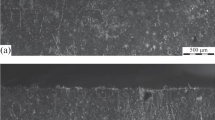Abstract
The change in the physical and mechanical characteristics of thiokol sealants under the influence of micromycetes isolated in the tropical climate of the Republic of Cuba and micromycetes used as test cultures according to GOST (State Standard) 9.049–91 was studied. A slight deterioration in some characteristics of sealants after testing for fungal resistance was observed, which depended more on the conditions of the tests than on the species composition of the microbial cultures used.
Similar content being viewed by others
REFERENCES
C. Vallieres, A. L. Hook, Y. He, V. C. Crucitti, G. Figueredo, C. R. Davies, L. Burroughs, D. A. Winkler, R. D. Wildman, D. J. Irvine, M. R. Alexander, and S. V. Avery, “Discovery of (meth) acrylate polymers that resist colonization by fungi associated with pathogenesis and biodeterioration,” Sci. Adv. 6, Eaba6574 (2020).
S. A. Semenov, K. Z. Gumargalieva, and G. E. Zaikov, “Biodegradation of Materials, Parts and Technical Products,” in Combustion, Destruction, and Stabilization of Polymers (Nauchnye osnovy i tekhnologii, St. Petersburg, 2008), pp. 73–99 [in Russian].
E. N. Kablov, “Key Problem: Materials,” in Trends and Benchmarks in the Innovation Development of Russia (VIAM, Moscow, 2015).
E. N. Kablov and V. O. Startsev, “System analysis of the climatic effect on the mechanical properties of polymeric composite materials based on the data of Russian and foreign sources (review),” Aviats. Mater. Tekhnol., No. 2, 47–58 (2018).
F. Schmidt, Y.-S. Zimmermann, G. A. R. Benatto, B. Kolvenbach, A. Schaffer, F. C. Krebs, E. D. Hullebusch, and M. Lenz, “Biodeterioration affecting efficiency and lifetime of plastic-based photovoltaics,” Joule 4 (2020).
M. Y. Stepanova and N. I. Baurova, “Analysis of methods for determining the biostability of polymer composite materials used in mechanical engineering,” Polym. Sci., Ser. D 13, 345–348 (2020).
V. T. Erofeev, E. N. Kablov, V. O. Startsev, V. F. Smirnov, I. V. Erofeeva, V. V. Ushkina, D. V. Emelyanov, E. M. Balatkhanova, and S. A. Korotaev, “Research of the species variety of litobiont fungi sample from samples of cement composite materials containing limestone of various origin and subject to ageing under the conditions of Black Sea climate,” Arkhitektura i Stroitel’stvo, No. 2, 126–136 (2018).
E. N. Kablov, V. T. Erofeev, D. A. Svetlov, V. F. Smirnov, and A. D. Bogatov, “Biodeterioration in Spacecraft,” in Proceedings of the International Research/Practice Conference “Composite Materials, Theory and Practice” (Privolzhskii Dom Znanii, Pensa, 2015), pp. 40–46.
A. V. Polyakova, A. A. Krivushina, Yu. S. Goryashnik, and G. M. Bukharev, “Tests for microbiological resistance in field conditions of various climatic zones,” Trudy VIAM: Elektron. Nauch.-Tekh. Zh., No. 4, 12 (2016).
A. V. Polyakova, Yu. S. Goryashnik, G. M. Bukharev, and O. A. Eliseev, “Fungal resistance of sealants,” Polym. Sci., Ser. D 9, 195–198 (2016).
O. A. Eliseev, Ya. A. Bryk, and D. N. Smirnov, “Modificationof polysulfide sealanats by corrosion inhibitors,” Aviats. Mater. Tekhnol., No. S2, 15–21 (2016).
Ya. A. Bryk, O. A. Eliseev, and D. N. Smirnov, “Protection of magnesium alloys against corrosion by polysulfide sealants,” Trudy VIAM: Elektron. Nauch.-Tekh. Zh., No. 10, 10 (2017).
A. A. Krivushina and Yu. S. Goryashnik, “Methods for protection of materials and products against microbiological deterioration (review),” Aviats. Mater. Tekhnol., No. 2, 80–86 (2017).
S. Ghramrawi, J.-P. Bouchara, A. Corbin, S. Rogalsky, O. Tarasyuk, and J.-F. Bardeau, “Inhibition of fungal growth by silicones modified with cationic biocides,” Mater. Today Comm. 22, 100716 (2020).
Funding
This study was supported by the Russian Foundation for Basic Research, project no. 18-53-34006.
Author information
Authors and Affiliations
Corresponding author
Ethics declarations
COMPLIANCE WITH ETHICAL STANDARDS
This article does not contain any studies involving animals or human beings performed by any of the authors.
CONFLICT OF INTEREST
The authors declare that they have no conflicts of interest.
Additional information
Translated by A. Bulaev
Rights and permissions
About this article
Cite this article
Krivushina, A.A., Bobyreva, T.V. & Smirnov, D.N. Fungal Resistance of Thiokol Sealants to Tropical Microorganisms and Test Cultures. Part 2. Polym. Sci. Ser. D 15, 404–408 (2022). https://doi.org/10.1134/S1995421222030169
Received:
Revised:
Accepted:
Published:
Issue Date:
DOI: https://doi.org/10.1134/S1995421222030169




